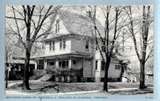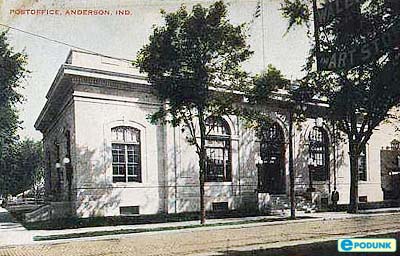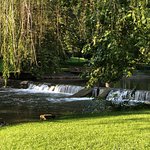A Early History of Madison County, Indiana
Willkie Home


Post Office, Anderson, Indiana

The Falls at Pendleton, Indiana
The earliest inhabitants of Madison County were the Moundbuilders, an Adena-Hopewell people whose massive earthworks are still visible today. In more modern historical times, this area was the home of the Delaware Indians.
Around 1794-95, Andersontown was a small Delaware Indian village and the home of the Great and Sovereign Delaware Chief Kikthawenud later known as Chief William Anderson. Three Moravian missionaries settled here from 1801 to 1806. After signing the Treaty of St. Mary's in 1818, the Delaware Indians were moved westward in 1820-21.
Madison County, Indiana, was first created in 1823 from the New Delaware Purchase. The county was named for James Madison, the 4th President of the United States.
John and William Conner arrived in the county at about this time. William, son-in-law of Chief Anderson, established a large trading post. He later sold it to John and Sarah Berry. They donated 32 acres(downtown Anderson) to the state for a town and on November 7, 1827, Berry laid out the first plat and one year later Andersontown became the county seat. It remained a small village until the early1850's with the coming of the Indianapolis Bellefontaine Railroad.
The most significant population movement came from the southern states, specifically the upland South, Virginia and North Carolina. Next in population size was the mid-Atlantic regions of New York and Pennsylvania. The smallest size came from the New England states.
While some early pioneers squatted where they "darned well please," others understood the wisdom of obtaining a clear land title. The federal land policy made ownership relatively easy. Fundamental to settlement was the pioneer family. The movement west was a family experience; hardly anyone pioneered alone. Individual men or groups selected a site and constructed a crude house, cleared the land and planted a crop. With this done, they returned home to bring the family.
In 1822, a sufficient number of settlers had arrived to generate interest in organizing the county. People gathered in various wilderness settlements to discuss the possibility. Interest held wide support in establishing a county. When the state legislature met at Corydon on December 2, 1822, a bill was introduced and passed both houses, and was approved by Gov. William Hendricks on Jan. 4, 1823.
On March 31, 1887, natural gas was discovered in Anderson. With this discovery, several businesses located here, lured by the prospect of cheap energy. The natural gas wells which supplied the city with cheap energy began to run out by 1912. Many of the industries which located here moved to other locations, but the Commercial Club(the early Chamber of Commerce) was able to persuade the Remy brothers to stay. Remy Electric Company was eventually bought by General Motors and expanded.
No industry has been more important to Anderson in the 20th century than the auto industry. An early automobile pioneer, John W. Lambert, located his Buckeye Manufacturing Works here and for several years built the Lambert automobile. Before 1920, 17 different types of automobiles were made here. Since the 20's, the auto parts industry has employed more people than any other in the county.
Source: Anderson Public Library and Stephen T. Jackson, Madison County Historian
Madison County Historical Society|15 West 11th Street, P. O. Box 696, Anderson, Indiana 46015-0696|(765) 683-0052|madisonchs10@gmail.com